

2012-11-25 08:55:00
Yesterday was an interesting experience! As I remarked to Nick-sempai: "Whoa, I've never sat this far right in shoukai (詳解)!. What a different view!". Because Renshinjuku Almere is still a relatively new dojo, with a slow growth and retention rate, I'm already moving further towards the right of the shimoza (student seating). This is only in part due to my personal progress, but mostly due to the skewed balance between beginners and kendoka in bogu. While I am aware that I'm making good progress towards my first real grading I won't delude myself into thinking I'm getting good at kendo ;)
So what was so interesting about yesterday? That skewed balance and its results! For example, yesterday we had six guys in bogu (incl Ton-sensei) and twelve beginners in uniform or normal sports gear. That's why we ran class using the motodachi system, where groups of beginners line up to train with more advanced students. Yesterday's class forced myself and the others (none of whom have a dan grade) to think and act like proper seniors to the beginners. Instead of spending class training our own kendo, we paid proper attention to theirs while providing encouragement and corrections when needed. I enjoyed it a lot and it was a great learning experience!
After kihon practice in the motodachi rotation, the beginners went with Bob-sempai to train kirikaeshi and other basic techniques. The four of us spent another half hour doing jigeiko under the watchful eye of Ton-sensei. Because Nick-sempai was preparing for today's shinsa (exams), Ton wanted us all to focus on clean and basic kendo. Dou-strikes won't be needed and cleanly break from taiatari instead of trying hiki waza.
Some pointers that I got:
Now, with regards to my own first grading I've heard a lot of different things. Originally my goal was to test in the winter of 2013, but I'm thinking of moving it forward to the summer of 2013. Some of my sempai will also be testing in the summer, so I'd love to join them.
In order to prep for the exams, I've made this shortlist of things that I must improve before the test.
All other things will slowly and gradually keep improving. But these two really require my attention.
kilala.nl tags: kendo, sports,
View or add comments (curr. 0)
2012-11-23 22:59:00
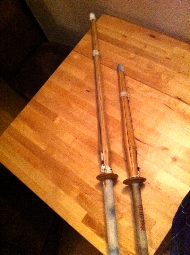
Tonight was well spent :)
I managed to fix a further three shinai using the spare parts Ton-sensei left me and that Bert-sensei donated. Two shinai of the dojo and one of my own are now in tip-top shape again. As a side project I took a bunch of broken or split take and created a suburi shinai for inside the house. At 85cm it's still a bit too long (a wrong swing will hit the ceiling), but at least it's usable :)
Also, at 85cm it's much too long to be used officially as a kodachi (regulation size is 62cm), but maybe it'll be usable for some practice anyway ( ^_^)
kilala.nl tags: kendo, creative,
View or add comments (curr. 0)
2012-11-20 18:36:00
Last tuesday was an interesting class in Amstelveen: in preparation for the shinsa (kendo exams) next sunday our students were studying kata. While we study kata on a weekly basis in Almere, in Amstelveen it's a much rarer occasion.
I was asked by Bert Niezen-sempai to join him in practicing kata. While he's more experienced in kendo than I am, he indicated that he'd like my help in kata. We learned a lot, under the watchful eye of Ran-sempai who spent the better part of 45 minutes coaching us personally. During the practice I was always uchidachi ("attacking sword"), while Bert was shidachi ("receiving sword"). He had a lot of points for improvement, the following for me.
After kata practice we immediately went into 20 minutes of jigeiko (only preceeded by three rounds of kirikaeshi). I did three rounds where, sadly, I got progressively worse. My round against Zicarlo-sempai was pretty good and he helped me a lot! Against Onno-sempai I got worse insofar that I started shutting down. Finally, against Bertolino-sempai I excused myself because I noticed that I really wasn't acting properly. My head was mostly hazy and I was slow to react, or not even reacting at all.
Learning points:
kilala.nl tags: kendo, sports,
View or add comments (curr. 0)
2012-11-17 22:06:00
The time has come to prepare for the 2012 NKR shinsa (kendo exams). As we already mentioned, the exam consists of four parts:
Many things have already been said about kirikaeshi and jitsugi, so let’s spend a little more time preparing for the kata exam!
In his 2012 book “Kendo Coaching: tips and drills”, George McCall writes on the subject of kata:
If we look at the word KATA in Japanese, its usually rendered as å½¢. However, the actual proper usage is åž‹. Both read the same, but what’s the difference? The former simply means “shape” or “form.” It describes the form that something is in, what it looks like. The second kanji, on the other hand, is the thing that is used to create items of the same shape, in other words, a cookie cutter like device.
Kendo-no-kata can therefore be thought of as a kendo shaped cookie cutter and the students who practice it cookies (hopefully kendo shaped). Although non-Japanese readers might not be interested in the difference, I think that one of the main purposes of kata study is revealed: i.e. kata training was/is traditionally thought of as one of the main vehicles to teach people correct kendo.
Kendo kata help us study proper posture, maai as well as seme. By practicing sword fighting in a simulated and choreographed fashion we can focus completely on the intricacies of our body, of our movements and of the connection with our opponent. We also learn to judge distance, which helps us in our kendo.
Also, while kendo is an abstraction of true sword fighting, the kendo kata approach “real” fighting closer. Both the techniques used, as well as our bokken help us understand the more serious side of our art which entails life or death situations. They’re no kenjutsu of course, but the kata are absolutely a useful tool in understanding and learning kendo.
Some suggest there is also a spiritual side to kendo kata. In Inoue-sensei’s “Kendo Kata: essence and application” it is said that kata #1 through #3 show the progression of a kenshi in his studies. While at first he will win a fight by outright killing his opponent, he will then move on to win by only dismembering. Finally the kenshi will grow so far that he does not have to strike at all, winning by pure seme(kata #3). The UK kendo foundation has some further reading on this subject.
Students first learning about kendo kata are advised to first observe a number of videos. The web is rife with kata videos, so we’ve taken the time to choose a number of good ones.
First up, there is a series of classic AJKF training videos (in Japanese). They are a bit dated, but they go over each kata in exquisite detail by filming from various angles and by zooming in on important parts. They also show examples of what not to do. Below are the first four kata, the other videos can be found under the YouTube account that posted these videos.
Another excellent video was made by Kendo World at the 2012 keiko-kai. While it only shows each kata once or twice, the demonstration is still very impressive.
Should you be inclined to deeply study each kata in written form, then we heartily recommend Stephen Quinlan’s “Nihon Kendo no Kata & Kihon Bokuto Waza”. In this excellent and thorough document (free PDF) mr Quinlan analyzes each kata, which is accompanied by many photographs.
kilala.nl tags: sports, kendo,
View or add comments (curr. 0)
2012-11-14 22:07:00
In less than two weeks time the NKR will host its semi-annual kendo grading exams, at the November centrally training. A number of our Renshinjuku students will take part in these examinations in order to test their current level. For many of them, this will be their first grading outside our own dojo, so we would like to take this opportunity to provide some information on the subject.
According to the NKR website, the requirements for kendo examinations are as follows:
The kata requirements differ per level. Ikkyu aspirants need to demonstrate kata#1through #3, shodan will show #1 through #5, nidan goes up to #7 and anything above nidan will display all ten kata. Aside from above requirements, there are also some formalities to clear, such as minimum age and a few payments.
For the purpose of this document I will limit myself to the ikkyu grading as I have no experience at all with the higher levels.
Before the grading, or shinsa, even begins there is the matter of proper presentation. If a shiai (tournament) would be compared to a business meeting, then a shinsa would compare to a gala: at the prior you are expected to dress and behave well, at the latter you are to act your very best! Apply proper personal care (nails clipped, hair properly kept, shaven if applicable) and make sure your equipment looks the part (proper maintenance, no loose ends, repairs where needed). Remove all dojo markings from your uniform and also remove your zekken. Make sure you wear your uniform and bogu neatly: no creases in the back, all himo at the same length, all himo lying flat, etc.
In kirikaeshi remember that it’s not a test of speed, but a test of skill. Show your best kirikaeshi by not rushing through it, but by paying attention to all details: footwork, timing, upswing through the center, downswing at an angle. Strike men at the proper angle and height. You are trying to strike ippon every time. As Heeren-sensei has pointed out repeatedly, your kirikaeshi should be performed in one kiaiand breath.
Fighting in jitsugi should not be compared go shiai kendo, but instead is more alike to the jigeiko we do in class: it is not a fight for points. Instead, it is a fight to show and test skill. Do not be preoccupied with scoring points and with defending against your opponent. Focus on ensuring that the both of you show your best and high quality kendo. Show a
connection between yourself and your opponent, show proper seme, show zanshinand show an understanding of your opponent’s actions.
The kata examination should show a similar connection with your opponent. Kataare not a simple choreography, kata are a study in forms of a proper sword fight. If possible, take it even more seriously than jitsugi or jigeiko as the bokken represents a real blade. Make sure that you have memorized the forms beforehand, then lock eyes with your kata partner and commence the “dialogue” that each exercise is.
In all of the above examinations kiai is key. I was once told that “in the early stages of kendo, >95% of kendo is kiai“. Whether that is really true is another thing, but the essence of the matter is that kiai is important. It regulates your breathing, it vocalizes your intent and assertiveness, it impresses your opponent and it is part of yuko datotsu. Without kiai there is no spirit, without spirit there is no kendo only stick fighting.
At this level, the gakka (written exam) focuses on basic knowledge of kendo. Terminology, equipment knowledge, basic concepts as well as rules and safety are topics you may expect to find on the test. In preparation ensure that you are familiar with most of the terms in our dojo’s lexicon. The AUSKF also has an excellent gakka study guide, listing some of the common topics that you can be questioned on, including suggestions on what to study.
If you have questions about the upcoming shinsa, please feel free to ask your teachers. If you feel that you need feedback on your kendo in the next few weeks, please indicate this to your teacher.
kilala.nl tags: kendo, sports,
View or add comments (curr. 0)
2012-11-13 21:46:00
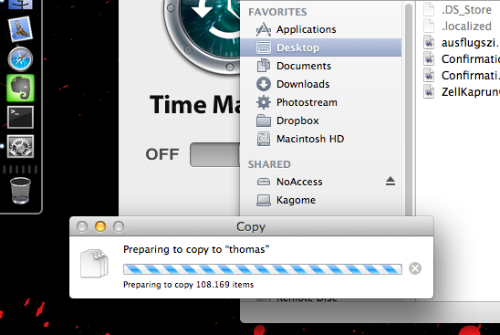
I've always been pretty "okay" about making backups. For years now I've been pulling drive images of both our Macbooks every month or two and both our systems run hourly backups to our NAS. Huzzah for Time Machine! Well, this weekend I got the chance to test our backups!
Having been bitten by the MMORPG bug after watching to much of SAO, I decided to save a lot of time (and money?) by closing the tab with worldofwarcraft.com and by reinstalling Warcraft 3. A few years back my brother-in-law Hans had given me the game for Christmas, so I still had the discs lying around. But! They're for PPC Macs only and obviously my Macbook has an Intel processor. Luckily you can download a Univerisal Binary version of the game through Battle.net (Blizzard's online store etc), after entering your CD keys. Which i promptly did.
Turns out that the whole Warcraft 3 game is a Universal Binary, except the bloody installer! WTF Blizzard?!
The solution is easy, yet stupid: install Snow Leopard (Mac OS 10.6) onto an external USB drive, which still has Rosetta (OS X's way to run PPC code on an Intel system). Everything went fine and I got the game installed. But when I tried to reboot to my Macbook's internal drive, I was greeted by the dreaded blinking question mark. Fudge! ( =_=)
The boot drive had gotten corrupted along the way. I have no clue whatsoever why, but it did. The only course of action, after I couldn't get the full disk encryption to open up, was to re-image the drive and restore from backups. The first part was easy: hook up my backup drive, boot from USB install stick and use Disk Utility to re-image. But then came the restore from Time Machine.
As a Unix admin I was over thinking the whole process! I was afraid that, if I were to simply reconnect the Time Machine backup drive, the TM software would erase everything and overwrite it all. So instead I tried to use the good old Migration Assistant, which usually is a great idea. But no matter what I tried, it failed: MA wouldn't see my backups over the network and they wouldn't show up when connected locally over USB either. Turns out there are two good reasons for this:
Turns out that what I was afraid of, really is the right way. So here's the course of action that works:
It could be that your restore borks once or twice, because a file is being locked by a running process. Most likely this is a cache in Library, or a plist locked by iCloud syncing. You could temporarily turn off all syncs and remove the offending files.
In my case, over 126.000 files were restored ringing in over 32GB.
View or add comments (curr. 0)
2012-11-10 17:16:00
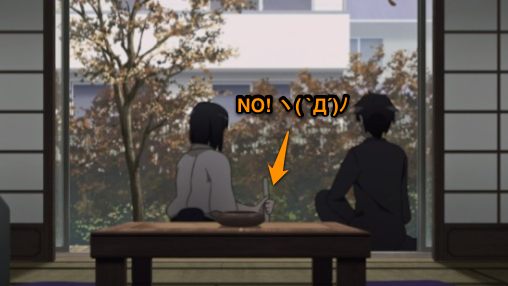
Over the past few weeks I've been following one of 2012's hit anime: Sword Art Online (trailer). I love the art work, the music, the character designs, the plot and the character development. It really is an awesomely engaging show.
It is because I love this show so much that the above screencap irks me so! They put so much effort into the show, but then make such a basic mistake! If Suguha (Kazuto's niece) is such an accomplished kendoka, who's been practicing kendo for over ten years, then she would not put a shinai with its tip down to the ground! WTF A-1?!
ヽ(#`Д´)ノ
kilala.nl tags: kendo, japan, anime, meh,
View or add comments (curr. 0)
2012-11-07 07:44:00
Last night turned out to be excellent!
What with the bad weather I'd left home a bit early so I'd be in time to pick up Charl from the P+R at Diemen. I arrived in time, but his bus didn't. Running almost half an hour late we stumbled into the dojo while almost everyone was already dressed. I was affraid we wouldn't be able to join in, but luckily we were simply welcomed in. It certainly was one of my fastest attempts at getting dressed ;)
Having missed the running, we joined in with the stretches and suburi. In the middle of stretching I was approached by Bert-sensei, to quickly talk about getting some replacement take for my shinai (which broke recently) and the ones I'm repairing for the dojo. He indicated that I could grab a shinai of my liking from the spares box, to take apart. Awesome! He also gave me a koban shinai (a practice sword with an oval handle) as a present. Double awesome! ( ^_^)/
During seiretsu, Heeren-sensei indicated that we will be using the next few weeks to prepare for the NKR shinsa (25th of november). This means that we will not be focusing on shiai kendo, but on clean and proper kendo. Focal points for the next few weeks are seme, ki-ken-tai ichi, and zanshin. Pay close attention to your posture, to your footwork, to your strikes, so you can demonstrate your ability at its best.
In accordance with our study goals, today's class focused on kihon practice just like last week. Using the motodachi system we practiced kirikaeshi, oki men, chisai men, oki kote-men, chisai kote-men, oki dou and repetitions of men, kote-men, dou, kote-men-dou. Students were encouraged to display proper kiai and to the timing of their footwork, which should match their strikes.
Funny thing: class started out in mawari geiko style (rotating the whole group), but was switched to motodachi style right before I was switched to the shidachi side. In a later chat with Heeren-sensei he told me he was very curious how I would deal with that situation, knowing about my problems with breathing and panic. Whenever I'm on the shidachi side I'm bowing out pretty early, but now that I was on the motodachi side he knew I was stuck: I have a responsibility to the people on the shidachi side, because without me in my spot those people cannot practice. As Marli said when I explained this: "Booooy, he's got you pegged! He knows exactly how to get to you!" and she's right :)
Well, it worked: the added responsibility meant that I finished class just about completely and I didn't bow out from kihon practice. I am very happy that I pushed through for the shidachi I practiced with and I learned a thing or two. Sure I got tired quickly, but that was solved by foregoing my own practice two or three times: let shidachi practice, then skip my own drill to catch my breath.
Heeren-sensei took a little time to demonstrate that oki dou starts out looking like a normal men strike. You start going for men and when your opponent raises his shinai to parry, you bring your shinai to your shoulder (or sometimes higher) and strike dou. As always it is important to:
Heeren-sensei indicated that, to practice this dou strike, it is best that motodachi does not open up dou beforehand but that motodachi should only start opening when shidachi moves to strike men. He also suggested that, when paired against someone considerably shorter than yourself, you can slightly lower your posture by sinking down on your legs a bit.
Kihon practice was followed by fifteen minutes of jigeiko and of course kirikaeshi. After two rounds of geiko (thank you Charl, thank you mr Goto) my breathing got the better of me and I had to bow out. After a short recuperation I joined the bogu-less group to practice some oki kote-men and chisai kote-men with Raoul-sempai. I'm very happy that Raoul saw improvement in my kendo since the last time I'd practiced with him. He indicated that my right hand was still a bit too tense and thus too slow, but in general he saw improvements!
After class, Heeren-sensei reiterated that we need to practice proper and good kendo for the examinations. He also informed us that, starting next Saturday, class will include kata geiko which is also needed to prepare for the exams. He advised everybody to prepare by researching the kata they need to know and to watch a few videos. He also asked the kendoka with kata experience to provide guidance to their classmates.
kilala.nl tags: kendo, sports, awesome,
View or add comments (curr. 2)
2012-11-05 07:35:00
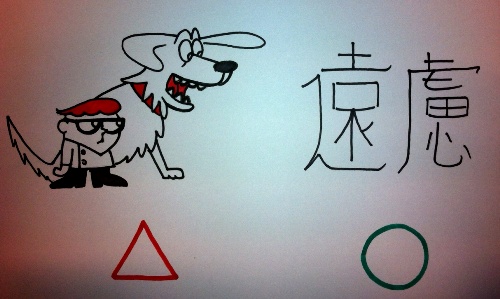
Recently I started a coaching process with Rockover Coaching (about which I'll write more later). In our third fruitful session I was assigned a bit of homework: make a structure for use in the office, to remind me of some of my personal DOs and DONTs.
In this case the DONT is my at-times hyperactive approach in communicating: too fast, not letting people come to their conclusions, sticking my nose in and generally forcing an opinion. The DO is the polar opposite of this, which I have already set as goal for 2012: enryo, self-restraint, calmness and respect. The intention of the structure is to put something in place that inherently reminds me of these DOs and DONTs at any given time, so I chose to hang up a poster at my desk.
Looking for graphics that trigger the DO and DONT in my mind, the DO is obviously represented by the kanji for the word "enryo" (as discussed before). When it came to the DONT one thing immediately popped into my head: Dexter's Laboratory's talking dog. The overly excited, busybusy, shouty dog who yelps for attention exclaiming that "I FOUND THE THING! THE THING! I GOT THE THING!" Or that's how it went in dutch, in english apparently it's "found you", but hey.
So... The above poster is what I whipped up in a few minutes and as per this blogpost it's delivered to my coach. There you go sir! ;)
kilala.nl tags: coaching, enryo, work,
View or add comments (curr. 3)
2012-11-04 11:12:00
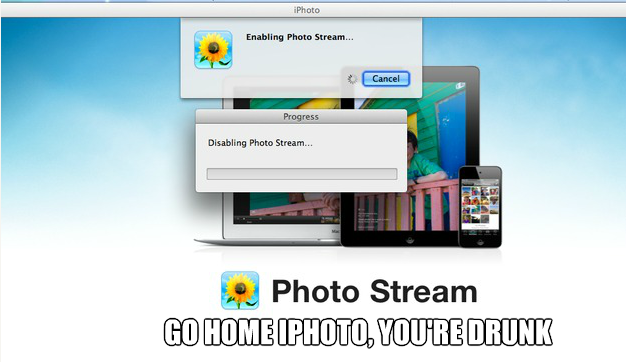
I've fought with iPhoto before and by now I'm not nearly as happy with it as I used to be. Could be that it's getting wonky now that we have 16.000+ photos in there, but who knows. The screenshot above was just the latest bout of craziness :)
View or add comments (curr. 0)
All content, with exception of "borrowed" blogpost images, or unless otherwise indicated, is copyright of Tess Sluijter. The character Kilala the cat-demon is copyright of Rumiko Takahashi and used here without permission.